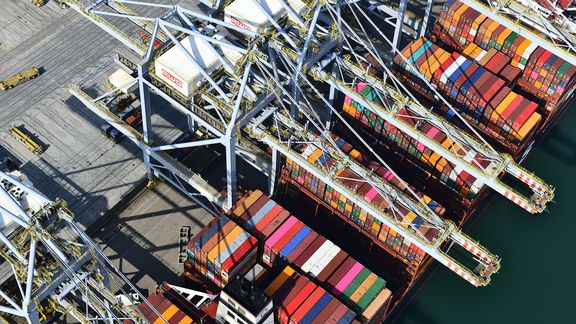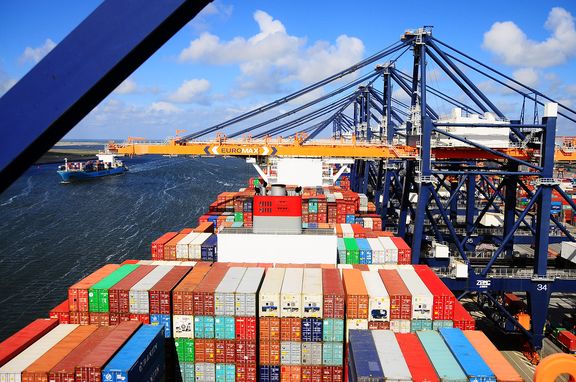Disruption dissected
Disruption. A word you hear much too often. Once referred to start-ups that wanted to make life difficult for the established order with smart, digital solutions. Since the start of this century's roaring twenties, it has mainly become synonymous with disruptions - some would even say chaos - in the logistics sector. Normalisation is a key focus. A talk with industry experts about the causes and solutions for container shipping.

Hans Nagtegaal is director Containers at the Port of Rotterdam Authority and enthusiastically presents his analysis. ‘Disruptions are obviously nothing new. In logistics, we have regularly been confronted with mist, storms or strikes, which caused havoc in the region. However, that was always limited in terms of time and geography. There was always a way round. Covid brought us long-term, global disruption for the first time. And along with upscaling, for example, the impact of disruptions is getting bigger.’
Confronted with the sudden drop in demand and the sombre prospects after the initial mass lockdowns in 2020, shipping companies initially started taking more vessels to the ship dismantling yards. This not only saved maintenance costs, but also provided extra liquidity for the sold scrap, as a buffer to get through the expected crisis. In the third quarter of 2020 alone, 170 freight ships were dismantled at locations all over the world.
Totally unnecessary
‘In March 2020, even we made significant cutbacks in capacity and manpower,’ says Cuno Vat, CEO at Neele-Vat Logistics, which has ten distribution centres totalling 256,000 square metres close to the container terminals in Rotterdam and Amsterdam. ‘Only to discover two months later that it was totally unnecessary. After a small dip, trade continued as usual...’
‘During the lockdowns, you did see a huge boom in garden furniture and DIY tools,’ Rogier Spoel, senior policy manager Air and Sea Freight at evofenedex, explains the situation. ‘Delays, partly a result of quarantine measures and reduced transport capacity, led to shops being unable to sell. And that quickly led to a mind shift in retail, but also in the industry. Just-in-time became just-in-case.’
Kees Groeneveld, president of the Association of Rotterdam Shipbrokers and Agents (VRC) shares that analysis. His members represent over ninety percent of the sea-going vessels which visit the port of Rotterdam. ‘During Covid, more were actually ordered. Many physical shops were closed and unable to sell their stocks, while - some new - webshops were suddenly faced with extra demand. Because the disruptions were already becoming visible, orders increased and were placed sooner. In turn, that created full warehouses.’
Overstretched
‘So, we've ended up in a situation in which the entire system is overstretched,’ says Vat, who is also president of Fenex, which represents freight forwarders and logistics services in the Netherlands. ‘Whether it involves the shipping companies, the terminals, warehouses, inland navigation or freight transport by truck or train. A small disruption always has a snowball effect because we miss the “slack” in the capacity.’
And there have been plenty of reasons for those delays in the recent period. From the Ever Given which blocked the Suez Canal to extra lockdowns and quarantine measures in China. And from storms in California and the Russian invasion of Ukraine to strikes of port employees in Germany.
Dwell times
Hans Nagtegaal of the Port Authority takes a look at his dashboard with the most up-to-date figures for 2022. ‘Over five percent more full and empty containers to and from Asia. In terms of volume, it's not too bad, but the delay affects everyone. Container ships used to do the Asia-Europe-Asia trip in seventy days. Now they take a hundred days. And the dwell times - the time that containers are waiting between logistics operations - have risen significantly. From four to ten days, just in the deep sea terminals.’
‘This means that our terminals are too full,’ explains Rob Bagchus, who works at ECT and is president of the Rotterdam Terminal Operators’ Association. ‘All those containers staying longer in the terminals take up capacity. This not only applies to the deep sea terminals but also to the inland terminals and the other storage and transport capacity. And we certainly aren't doing worse in Rotterdam than in neighbouring ports. It's then not so much about congestion in the port, as you often read in the newspaper, but much more about disruption throughout the logistics chain.’
150 billion euros
An additional point is that the scarcity also has another side. Rates throughout the sector have risen considerably, as has profitability. What's more, the shipping companies are increasingly the focus of attention. Spoel from evofenedex: ‘Last year, they made a joint record profit of 150 billion euros. This year, that will double. For a long time, shipping lines had a marginal existence, but the losses have now certainly been compensated.’
Even though VRC president Groeneveld, in daily life managing director of Euro Nordic Logistics, partially agrees with this analysis, he says that this development applies to more parties in the chain. ‘In the past, many companies in logistics were fairly squeezed, but they too saw opportunities in the scarcity to significantly raise the rates and increase profitability.’

Silver bullet
According to Nagtegaal, the problem cannot be resolved by one party. Everyone will need to make compromises. ‘We too often encounter the attitude of: “if someone else changes, I can continue doing what I always did”. We need to move away from that, and it's exactly the reason why we as the Port Authority are facilitating sectoral consultation.’ Cuno Vat totally agrees. ‘Talk to each other. There's no quick fix and no silver bullet. For example, I think that there's a lot of profit to be gained from improving how we use the capacity. More use of the hours in the evening, night and weekend. These are now underused. That means thinking creatively and constructively with each other. About investing in clean and quiet transport, for example, so that shops in the city centre can be restocked at night. And about how we can bear the extra personnel costs for working at night and in shifts together, so that the entire sector can benefit from the better security of supply resulting from better distribution.’
‘Reliability is our biggest asset,’ Bagchus chips in. ‘We all need to be less noncommittal about that. As terminals, we already have good agreements with inland navigation via “fixed windows” and other concepts. The same applies to truck appointment systems.’
Spoel wants to extend this system to the ports. ‘Now shipping companies are not or rarely reprimanded by the ports if they arrive late. People are afraid that the shipping companies will choose a different port in future. Port authorities in north-west Europe should act together more and take a uniform approach. That makes a difference.’
Ports specialise
On behalf of evofenedex, Spoel has another tip in that respect. ‘Ports should specialise much more. Not want to do everything but focus on certain types of freight and organise the most efficient transport to and from the hinterland. In Rotterdam, you might also wonder whether all that transit and transhipment is really such a good idea. It creates enormous pressure on the logistics chain but adds very little value for us as a country and society.’
Something all the interviewees agreed on is that more sector-wide insight is needed into the different links in the logistics process and its planning. Kees Groeneveld: ‘We need to share a lot more data with each other. Not stamp everything as confidential. For example, shipping companies should inform terminals what the second move will be so that they can prepare for that, and the predictability of cargo flows will increase.’
Petty
Cuno Vat: ‘Too many parties keep their cards close to their chest. It's incredibly difficult to gather information that provides insight into the whole process.’ In this respect, Hans Nagtegaal points to Nextlogic and Portbase. Such digital platforms and planning tools take us further as a sector. We need to use them to get on with things and not hide behind the excuse of 'no capacity to implement them' or 'we only release this kind of information via our own website'. The reason for the latter being to increase the number of clicks on the website. That's how petty things can be.’
Where some solace is obviously expected is the expansion of capacity. That extends beyond merely extra vessels and terminals. Groeneveld: ‘Having enough employees is increasingly becoming a bottleneck. We should take a more neutral view of digitisation and robotics, without the age-old “njet” from the trade unions. Because everyone needs to be willing to take a leap of faith to resolve this.’
Extra deep sea jetties
The VRC expects the first really substantial extra cargo from new ship capacity in 2024. Groeneveld: ‘That will make a difference, but there must obviously also be extra terminal capacity to process those cargo flows. Furthermore, the city is increasingly using the old port basins for housing and recreation. And all the hydrogen-related plans need a lot of space too. Perhaps it's time to seriously consider a Maasvlakte III.’
Nagtegaal: ‘That extra terminal capacity is exactly the reason why, as Port of Rotterdam Authority, we are investing at our own expense and risk in extra deep sea jetties in the Amaliahaven, and in the development of the Container Exchange Route (CER). However, the most important thing is that we resolve this together. The recently launched chain consultation is a good example of that. It ensures growing understanding for each other's situation. From there, you can build on solutions.’